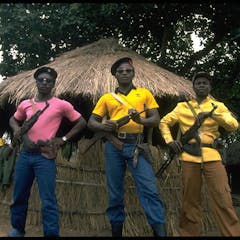
Articles on Civil war
Displaying 1 - 20 of 127 articles

Abortions happened in Arizona, despite a near-complete abortion ban enacted in 1864. But people also faced penalties for them, including a female doctor who went to prison.

Hopes for a peaceful resolution are fading as the Sudan civil war blazes into a second year.

Haiti will be able to emerge from the crisis it is in if it has a strong public administration and co-ordinated international aid from countries that respect human rights.

Messi will not start a war in China, but this is not to say that football lacks political relevance.

A major hurdle in South Sudan is the presence of detractors who could undermine the successful implementation of peace agreements.

Beijing is losing patience with Myanmar’s military, as well as its influence with resistance groups.

Colonialism set Nigeria up for failure as a united country. But successive governments since independence have a lot to answer for too.

Buthelezi should not be dismissed as a mere stooge during apartheid. Yet, he deserves little praise as an advocate for human rights and civil liberties.

The political elite have held on to power through power-sharing arrangements rather than the ballot. How will that change?

As current chair of the regional body ASEAN, Indonesia is tasked with resolving a conflict that has killed thousands. Progress has been slow.

The sites provide a rare tangible record of the international solidarity that existed during the Cold War.

There was one central reason the Civil War happened.

Yemen’s brutal civil war has resulted in the deaths of hundreds of thousands of people. But a recent Beijing-brokered rapprochement between two regional powers could unlock a path to peace.

Evacuations offer some hope, but only for those that qualify for them.

Since seizing power in a 2021 coup, Myanmar’s military has killed more than 3,000 civilians and pro-democracy activists. But the army has struggled to contain an armed resistance movement.

Policies that reduce poverty, inequality and socioeconomic insecurity lower the incentive to engage in or tolerate terrorism.

More than half a million people have died in Syria’s war with half the population displaced. The suffering will continue until there is a reckoning with Assad and his allies.

What deep-dive polls reveal at the political landscape of America as the 2022 midterm election approaches.

Two academics have identified the perpetrators of a massacre committed in 2013 by Syrian loyalist forces. An episode that says a lot about the reality of Syria in the last 10 years.

A prolonged economic recession triggered by falling oil prices and worsened by the COVID pandemic has deeply affected the everyday lives of Angolans.
